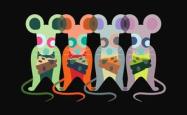介绍中国春节美食和文化英文作文
Title: Exploring Chinese Spring Festival Cuisine
Chinese Spring Festival, also known as the Lunar New Year, is a time of joyous celebration, family reunions, and of course, mouthwatering cuisine. The festival, spanning over two weeks, is marked by a variety of traditional dishes that hold significant cultural and symbolic meanings. Let's delve into the delightful world of Chinese Spring Festival cuisine.
1. Dumplings (饺子)

Dumplings are an indispensable part of the Spring Festival feast. These little pockets of joy are traditionally filled with minced meat and finely chopped vegetables, symbolizing wealth and prosperity. Their shape resembles ancient Chinese currency, making them a harbinger of good fortune for the coming year. During family gatherings, making dumplings together fosters a sense of unity and affection.
2. Glutinous Rice Cake (年糕)
Glutinous rice cake, or nian gao, holds a special place in Chinese New Year celebrations. The pronunciation of "nian gao" is similar to "year high," symbolizing progress, advancement, and the promise of a better year ahead. This sticky, sweet cake can be steamed, fried, or even panfried with savory ingredients like eggs and vegetables, offering a delightful contrast of flavors and textures.
3. Fish (鱼)
Fish is a musthave dish during Chinese New Year, as its pronunciation "yu" sounds like the word for surplus or abundance. Serving fish signifies a wish for abundance and prosperity in the coming year. The tradition is to leave some fish leftover to symbolize surplus in the new year. The fish is often served whole, representing unity and togetherness for the family.
4. Spring Rolls (春卷)
Spring rolls, with their crispy exterior and savory fillings, are enjoyed throughout the Spring Festival. Their name, "chun juan," translates to "spring rolls," symbolizing the arrival of spring and new beginnings. Filled with vegetables, meat, and sometimes seafood, these rolls are fried to golden perfection, signifying wealth and prosperity.
5. Longevity Noodles (长寿面)
Longevity noodles, also known as chang shou mian, are symbolic of a long and fulfilling life. These uncut noodles, often served in a savory broth or stirfried with vegetables and meat, represent longevity and good health. Eating longevity noodles during the Spring Festival is believed to bring blessings of longevity and happiness to the family.
6. Sweet Rice Balls (汤圆)
Sweet rice balls, or tang yuan, are a delightful treat enjoyed during the Lantern Festival, which marks the end of the Spring Festival celebrations. These glutinous rice balls, filled with sweet fillings such as sesame paste or sweet red bean paste, are served in a warm, sweet soup. Eating tang yuan represents family reunion and harmony.
7. EightTreasure Rice (八宝饭)
EightTreasure Rice, or ba bao fan, is a festive dessert often served during the Spring Festival. This sticky rice dish is filled with a mixture of sweet ingredients such as red bean paste, dried fruits, and nuts, symbolizing good luck and abundance. Each ingredient represents a different blessing, making it a cherished dish for celebrating the New Year.
Conclusion
Chinese Spring Festival cuisine is more than just food; it's a reflection of centuriesold traditions, cultural values, and hopes for the future. From dumplings to sweet rice balls, each dish carries its own symbolism and significance, enriching the festivities with meaning and flavor. As families gather around the table to share these delicious dishes, they also share love, laughter, and the promise of a prosperous year ahead.
Discover the essence of Chinese culture through its diverse and delectable cuisine this Spring Festival, and embark on a culinary journey that celebrates tradition, unity, and the spirit of renewal.
*Bon appétit! 恭喜发财! (Gong Xi Fa Cai!)*
本文 昆山生活网 原创,转载保留链接!网址:https://www.kunshanyanglao.com/bk/12082.html
1.本站遵循行业规范,任何转载的稿件都会明确标注作者和来源;2.本站的原创文章,请转载时务必注明文章作者和来源,不尊重原创的行为我们将追究责任;3.作者投稿可能会经我们编辑修改或补充。









